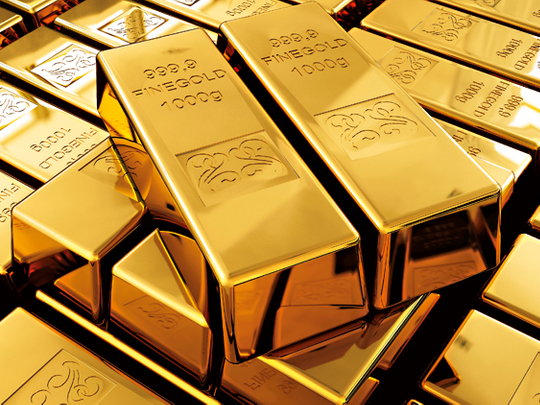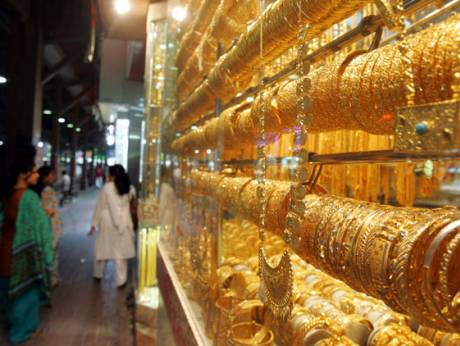
Dubai: Jewellery demand was subdued and there were plenty of takers for bars and coins — but this was not enough to stop global gold sales from slipping 18 per cent to 1,034 tonnes in the first three months of 2017 compared with a year ago.
Specific to the Middle East, shoppers — except those in Iran — were not inclined to make significant commitments on jewellery purchases, according to World Gold Council data.
VAT in UAE: Gold, jewellery, tobacco to be taxed
In the first three months, the region’s consumption of gold jewellery was “virtually unchanged” at 54.6 tonnes, with “growth in Iran (up 27 per cent over Q1-16 to 12.9 tonnes) contrasted with weakness elsewhere.
“Demand across the rest of the region remained weak in the face of low oil prices and subdued tourist numbers, the impact of which was exaggerated by rising gold prices,” the WGC report states.
“Although the UAE imposed a 5 per cent import duty, demand was relatively robust as consumers rushed to buy before the full effect of the tax fed through to end-user prices.”
And local jewellery retailers played it smart, by not immediately passing on the full 5 per cent import duty burden on to consumers.
But consumers remain extremely sensitive to any price appreciation, and gold's steady gains did crimp demand. And so did the continued absence of high spending tourist shoppers.
India: Pivotal market
Jewellery demand in India — the pivotal market for gold retail sales apart from China — showed signs of recovery, albeit a partial one. The full impact of demonetization and its telling effect on consumer demand thereafter will still require time to get back into full health mode.
“Given the shocks India’s gold demand faced in 2016, the industry is coming to grips with the new realities,” said John Mulligan, Head of Member and Market Relations at WGC. “It is taking time for the re-monetization to be accommodated by the market.
“The other question the gold market will need an answer for is the implication on demand from the upcoming GST (goods and services tax) implementation. And will it set off demand before it comes into effect (from July 1) or would it only mean more of business as usual?”
In the first three months, Indian jewellery demand shot up 16 per cent from last year’s "exceptionally low level", WGC finds. "Pent-up demand from the closing weeks of 2016 was gradually released as liquidity improved."
But the Q1-17 volumes of 92.3 tonnes is still rated as weak, given that this was only the third quarter this decade in which demand has fallen below 100 tonnes.
As for China, demand for jewellery “softened slightly” in the first quarter, by 2 per cent year-on-year.
Clearly, higher gold prices did curb consumer spending in what is a crucial period — coinciding with the Chinese New Year — for jewellery sales in the country. It translated into 176.5 tonnes compared with 179.2 tonnes in Q1-16 and 5 per cent below the five-year quarterly average of 186.4 tonnes.
Worldwide, bar and coin investment came to 290 tonnes, a gain of 9 per cent year-on-year.
According to Alistair Hewitt, Head of Market Intelligence at WGC, "Although we did not see the record-breaking surges in ETF inflows experienced in Q1-16, we have seen good inflows nonetheless this quarter, with strong interest from European investors ahead of the Dutch and French elections.
"Retail investment demand is strong too, up 9 per cent year-on-year with demand worth over $11 billion in Q1-17."
Keeping politics out of gold prices
A constant theme of 2016 was how political events – Brexit and trump, to name just two – were impacting on short-term gold pricing and how this played out on institutional and retail buyer demand. Will political events this year manage to do a repeat?
“Whenever news is interpreted as having economic implications, it will feed into the price,” said John Mulligan of World Gold Council. “There will remain constant tension between hard and soft indicators. What this creates is constant talk of the next big uncertainty - in the end, people will accommodate uncertainty.”
And there are also divergences in how institutional investors approach uncertainty and in how they respond on their gold purchases. Nowhere is this more marked than in the "divergence between US and European investors," said Mulligan.
"The US institutional investor market seems less inclined to be carried away," said Mulligan. "That explains why major inflows in (gold) ETFS (exchange traded funds) was largely a European story."
In the first three months, inflows into global ETFs totalled 109 tonnes which, "although solid, were nonetheless a fraction of last year’s near-record inflows", WGC states. "Slower central bank demand also contributed to the weakness."














